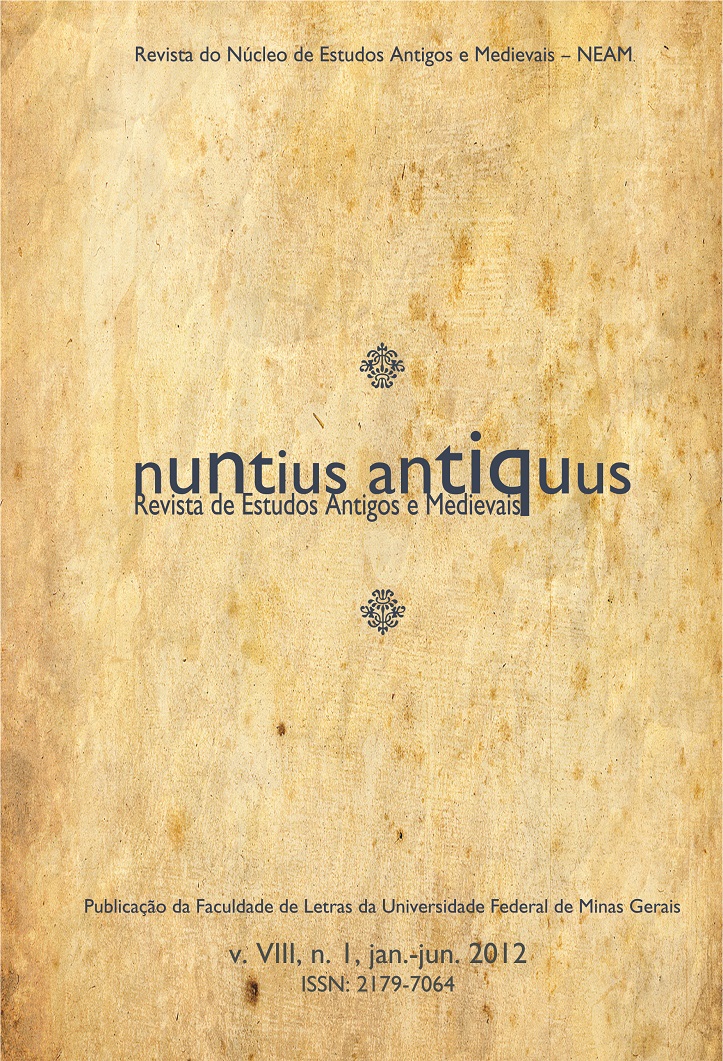Penélope e a arte da indecisão na Odisseia
DOI :
https://doi.org/10.17851/1983-3636.8.1.7-28Mots-clés :
Homer, Odyssey, Penelope, woman, indecisionRésumé
Abstract: The aim of this paper is to discuss some passages of the Odyssey that are important to the characterization of Penelope as “undecided” – at the same time someone who is victim and in the control of her destiny. I’ll try to show (as others did before) that this indecision, far from making Penelope an incongruous character, is responsible for her complexity and has a decisive role in drawing the narrative to an end.
Références
AUSTIN, N. Archery at the dark of the moon. Poetic problems in Homer’s “Odyssey”. Berkeley: University of California Press, 1975.
BYRE, C. Penelope and the suitors before Odysseus: “Odyssey” 18.158-303. The American journal of philology. Baltimore, v. CIX, n. 2, p. 159-173, 1988.
CLAY, J. Homeric “akhreîon”. The American journal of philology. Baltimore, v. CV, n. 1, p. 73-76, 1984.
COMBELLACK, F. Three Odyssean problems. California studies in classical antiquity. California, v. VI, p. 17-46, 1973.
de JONG, I. A Narratological commentary on the “Odyssey”. Cambridge: Cambridge University Press, 2001.
DI BENEDETTO, V. Omero: “Odissea”. Milano: Rizzoli, 2010.
FELSON-RUBIN, N. Regarding Penelope. From character to poetics. Princeton: Princeton University Press, 1994.
HARSH, P. Penelope and Odysseus in “Odyssey” XIX. The American journal of philology. Baltimore, v. LXXI, p. 1-21, 1950.
HEUBECK, A. et alii (Org.). A commentary on Homer’s “Odyssey”. v. III (books 17-24). Oxford: Clarendon Press, 1992.
HÖLSCHER, U. Penelope and the suitors (translated by Simon Richter). In: SCHEIN, S. (Org.). Reading the “Odyssey”. Selected interpretive essays. Princeton: Princeton University Press, 1996.
JONES, P. Homer’s “Odyssey”. A commentary based on the translation of Richmond Lattimore. London: Bristol Classics Press, 1988.
KATZ, M. Penelope’s renown. Meaning and indeterminacy in the “Odyssey”. Princeton: Princeton University Press, 1991.
LACEY, W. Homeric “hédna” and Penelope’s “kúrios”. The journal of Hellenic studies. London, v. LXXXVI, p. 55-68, 1966.
LEVINE, D. Penelope’s laugh: “Odyssey” 18.163. The American journal of philology. Baltimore, v. CIV, n. 2, p. 172-178, 1983.
LEVINE, D. Odysseus’ smiles: “Odyssey” 20, 301, 22, 371 e 23, 111. Transactions of the American philological association. Baltimore, v. CXIV, p. 1-9, 1984.
LOURENÇO, F. Homero: “Odisseia”. Lisboa: Cotovia, 2003.
MARQUARDT, P. Penelope “polytropos”. The American journal of philology. Baltimore, v. CVI, p. 32-48, 1985.
MONRO, D. Homer’s “Odyssey”. v. 2 (books XIII-XXIV). Oxford: Clarendon Press, 1901.
MURNAGHAN, S. Disguise and recognition in the “Odyssey”. Princeton: Princeton University Press, 1987.
NICKEL, R. Athene, Penelope and the vengeance plot against the suitors. Quaderni Urbinati di cultura classica. Urbino, v. XCVI, n. 3, p. 29-54, 2010.
PRATT, L. “Odyssey” 19.535-550: on the interpretation of dreams and signs in Homer. Classical philology. Chicago, v. LXXXIX, n. 2, p. 147-152, 1994.
ROZOKOKI, A. Penelope’s dream in book 19 of the “Odyssey”. The classical quarterly. Watford, v. LI, n. 1, p. 1-6, 2001.
RUSSO, J. Interview and aftermath: dream, fantasy, and intuition in “Odyssey” 19 e 20. The American journal of philology. Baltimore, v. CIII, n. 1, p. 4-18, 1982.
SAÏD, S. Homer and the “Odyssey”. Translated by Ruth Webb. Oxford: Oxford University Press, 2011.
STANFORD, W. Ambiguity in Greek literature. Oxford: Basil Blackwell, 1939.
STANFORD, W. The “Odyssey” of Homer. London: St. Martin Press, 1947.
STEWART, D. The disguised guest. Rank, role, and identity in the “Odyssey”. Cranbury: Associated University Press, 1976.










